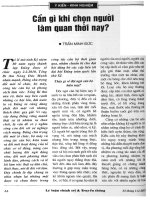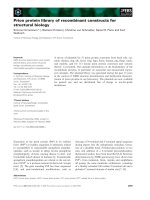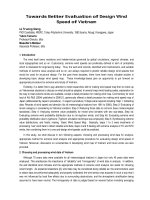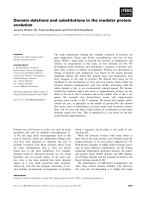Tài liệu Báo cáo khoa học: "Word to Sentence Level Emotion Tagging for Bengali Blogs" doc
Bạn đang xem bản rút gọn của tài liệu. Xem và tải ngay bản đầy đủ của tài liệu tại đây (259.93 KB, 4 trang )
Proceedings of the ACL-IJCNLP 2009 Conference Short Papers, pages 149–152,
Suntec, Singapore, 4 August 2009.
c
2009 ACL and AFNLP
Word to Sentence Level Emotion Tagging for Bengali Blogs
Dipankar Das
Department of Computer Science &
Engineering, Jadavpur University, India
Sivaji Bandyopadhyay
Department of Computer Science &
Engineering, Jadavpur University, India
Abstract
In this paper, emotion analysis on blog texts
has been carried out for a less privileged lan-
guage like Bengali. Ekman’s six basic emotion
types have been selected for reliable and semi
automatic word level annotation. An automatic
classifier has been applied for recognizing six
basic emotion types for different words in a
sentence. Application of different scoring
strategies to identify sentence level emotion
tag based on the acquired word level emotion
constituents have produced satisfactory per-
formance.
1 Introduction
Emotion is a private state that is not open to ob-
jective observation or verification. So, the identi-
fication of the emotional state of natural lan-
guage texts is really a challenging issue. Most of
the related work has been conducted for English.
The approach in this paper is to assign emo-
tion tags on the Bengali blog sentences with one
of the Ekman’s (1993) six basic emotion types
such as happiness, sadness, anger, fear, surprise
and disgust. The system consists of two phases,
machine learning based word level emotion clas-
sification followed by assignment of sentence
level emotion tags based on the word level con-
stituents using sense based scoring mechanism.
The classifier accuracy has been measured
through confusion matrix. Corpus based and
sense based tag weights have been calculated for
each of the six emotion tags and then these emo-
tion tag weights have been used to identify sen-
tence level emotion tag. The tuned reference
ranges selected from the development set have
proved effective on the test set.
The rest of the paper is organized as follows.
Section 2 describes the related work. Section 3
briefly describes the resource preparation. Ma-
chine learning based word level emotion tagging
system framework and its evaluation results have
been discussed in section 4. Section 5 describes
the calculation of tag weights, sentence level
emotion detection process based on the tag
weights, evaluation strategies and results. Finally
section 6 concludes the paper.
2 Related Work
(Mishne et al., 2006) used several supervised and
unsupervised machine learning techniques on
blog data for comparative evaluation. Importance
of verbs and adjectives in identifying emotion
has been explained in (Chesley et al., 2006).
(Yang et al., 2007) has used Yahoo! Kimo Blog
corpora containing emoticons associated with
textual keywords to build emotion lexicons.
(Chen et al., 2007) has experimented the emotion
classification task on web blog corpora using
Support Vector Machine (SVM) and Conditional
Random Field (CRF) and the observed results
have shown that the CRF classifiers outperform
SVM classifiers in case of document level emo-
tion detection.
3 Resource Preparation
Bengali is a less computerized language and
there is no existing emotion word list or Senti-
WordNet in Bengali. The English WordNet Af-
fect lists, (Strapparava et al., 2004) based on Ek-
man’s six basic emotion types have been updated
with the synsets retrieved from the English Sen-
tiWordNet to have adequate number of emotion
word entries.
These lists have been converted to Bengali us-
ing English to Bengali bilingual dictionary
1
.
These six lists have been termed as Emotion lists.
A Bengali SentiWordNet is being developed by
replacing each word entry in the synonymous set
of the English SentiWordNet (Esuli et al., 2006)
1
149
by its equivalent Bengali meaning using the same
English to Bengali bilingual dictionary.
A knowledge base for the emoticons has been
prepared by experts after minutely analyzing the
Bengali blog data. Each image link of the emoti-
con in the raw corpus has been mapped into its
corresponding textual entity in the tagged corpus
with the proper emotion tags using the knowl-
edge base. The Bengali blog data have been col-
lected from the web blog archive
(www.amarblog.com) containing 1300 sentences
on 14 different topics and their corresponding
user comments have been retrieved.
4 Word Level Emotion Classification
Primarily, the word level annotation has been
semi-automatically carried out using Ekman’s six
basic emotion tags. The assignment of emotion
tag to a word has been done based on the type of
the Emotion Word lists in which that word is pre-
sent. Other non-emotional words have been
tagged with neutral type. 1000 sentences have
been considered for training of the CRF based
word level emotion classification module. Rest
200 and 100 sentences, verified by language ex-
perts to perform evaluation have been considered
as development and test data respectively.
4.1 Feature Selection and Training
The Conditional Random Field (CRF)
(McCallum, 2001) framework has been used for
training as well as for the classification of each
word of a sentence into the above-mentioned six
emotion tags and one neutral tag. By manually
reviewing the Bengali blog data and different
language specific characteristics, 10 active fea-
tures have been selected heuristically for our
classification task. Each feature value is boolean
in nature, with discrete value for intensity feature
at the word level.
POS information: We are interested with
the verb, noun, adjective and adverb words
as these are emotion informative constitu-
ents. For this feature, total 1300 sentences
has been passed through a Bengali part of
speech tagger (Ekbal et al. 2008) based on
Support Vector Machine (SVM) tech-
nique. The POS tagger was developed
with a tagset of 26 POS tags
2
, defined for
the Indian languages. The POS tagger has
demonstrated an overall accuracy of ap-
proximately 90%.
2
First sentence in a topic: It has been ob-
served that first sentence of the topic gen-
erally contains emotion (Roth et.al., 2005).
SentiWordNet emotion word: A word
appearing in the SentiWordNet (Bengali)
contains an emotion.
Reduplication: The reduplicated words
(e.g., bhallo bhallo [good good], khokhono
khokhono [when when] etc.) in Bengali are
most likely emotion words.
Question words: It has been observed
that the question words generally contrib-
ute to the emotion in a sentence.
Colloquial / Foreign words: The collo-
quial words (e.g., kshyama [pardon] etc.)
and foreign words (e.g. Thanks, gossya
[anger] etc.) are highly rich with their
emotional contents.
Special punctuation symbols: The sym-
bols (e.g. !, ?, @ etc ) appearing at the
word / sentence level convey emotions.
Quoted sentence: The sentences espe-
cially remarks or direct speech always
contain emotion.
Negative word: Negative words such as
na (no), noy (not) etc. reverse the meaning
of the emotion in a sentence. Such words
are appropriately tagged.
Emoticons: The emoticons and their con-
secutive occurrences generally contribute
as much as real sentiment to the words or
sentences that precede or follow it.
Features Training Testing
Parts of Speech
First Sentence
Word in SentiWordNet
Reduplication
Question Words
Coll. / Foreign Words
Special Symbols
Quoted Sentence
Negative Words
Emoticons
432 221
96 13
684 157
18 7
23 11
35 9
16 4
22 8
67 27
87 33
Table 1: Frequencies of different features
Different unigram and bi-gram context fea-
tures (word level as well as POS tag level) and
their combination has been generated from the
training corpus. The following sentence contains
four features (Colloquial word (khyama), special
150
symbol (!), quoted sentence and emotion word
( [happy])) together and all these four fea-
tures are important to identify the emotion of this
sentence.
k o! “ত ক”
(khyama) (dao)! “(tumi) (bhalo) (lok)”
(Forgive)! “(you) (good) (person)”
4.2 Evaluation Results of the Word-level
Emotion Classification
Evaluation results of the development set have
demonstrated an accuracy of 56.45%. Error
analysis has been conducted with the help of
confusion matrix as shown in Table 2. A close
investigation of the evaluation results suggests
that the errors are mostly due to the uneven dis-
tribution between emotion and non-emotion tags.
Tags happy sad ang dis fear sur ntrl
happy
sad
ang
dis
fear
sur
ntrl
0.01 0.05 0.0 0.0 0.0 0.03
0.006 0.02 0.03 0.0 0.0 0.02
0.0 0.03 0.0 0.02 0.0 0.01
0.0 0.0 0.01 0.01 0.0 0.01
0.0 0.0 0.0 0.0 0.0 0.01
0.02 0.007 0.0 0.0 0.0 0.01
0.0 0.0 0.0 0.0 0.0 0.0
Table 2: Confusion matrix for development set
The number of non-emotional or neutral type
tags is comparatively higher than other emotional
tags in a sentence. So, one solution to this unbal-
anced class distribution is to split the ‘non-
emotion’ (emo_ntrl) class into several subclasses.
That is, given a POS tagset POS, we generate
new emotion classes, ‘emo_ntrl-C’|CPOS. We
have 26 sub-classes, which correspond, to non-
emotion tags such as ‘emo_ntrl-NN’ (common
noun), ‘emo_ntrl-VFM’ (verb finite main) etc.
Evaluation results of the system with the inclu-
sion of this class splitting technique have shown
the accuracies of 64.65% and 66.74% on the de-
velopment and test data respectively.
5 Sentence Level Emotion Tagging
This module has been developed to identify sen-
tence level emotion tags based on the word level
emotion tags.
5.1 Calculation of Emotion Tag weights
Sense_Tag_Weight (STW): The tag weight has
been calculated using SentiWordNet. We have
selected the basic six words “happy”, “sad”,
“anger”, “disgust”, “fear” “surprise” as the seed
words corresponding to each emotion type. The
positive and negative scores in the English Sen-
tiWordNet for each synset in which each of these
seed words appear have been retrieved and the
average of the scores has been fixed as the
Sense_Tag_Weight of that particular emotion tag.
Corpus_Tag_Weight (CTW): This tag weight
for each emotion tag has been calculated based
on the frequency of occurrence of an emotion tag
with respect to the total number of occurrences
of all six types of emotion tags in the annotated
corpus.
Tag Types CTW STW
emo_happy
emo_sad
emo_ang
emo_dis
emo_fear
emo_sur
emo_ntrl
0.5112 0.0125
0.2327 ( - ) 0.1022
0.0959 ( - ) 0.5
0.1032 ( - ) 0.075
0.0465 0.0131
0.0371 0.0625
0.0 0.0
Table 3: CTW and STW for each of six emotion
tags with neutral tag
5.2 Scoring Techniques
The following two scoring techniques depending
on two calculated tag weights (in section 5.1)
have been adopted for selecting the best possible
sentence level emotion tags.
(1) Sense_Weight_Score (SWS): Each sen-
tence is assigned a Sense_Weight_Score (SWS)
for each emotion tag which is calculated by di-
viding the total Sense_Tag_Weight (STW)of all
occurrences of an emotion tag in the sentence by
the total Sense_Tag_Weight (STW) of all types
of emotion tags present in that sentence. The
Sense_Weight_Score is calculated as
SWS
i = (STWi * Ni) / (∑ j=1 to 7 STWj * Nj) | i j
where SWSi is the Sentence level
Sense_Weight_Score for the emotion tag i in the
sentence and Ni is the number of occurrences of
that emotion tag in the sentence. STWi and STWj
are the Sense_Tag_Weights for the emotion tags i
and j respectively. Each sentence has been as-
signed with the sentence level emotion tag SETi
for which SWSi is highest, i.e.,
SETi = [max i=1 to 6(SWSi)].
(2) Corpus_Weight_Score (CWS): This meas-
ure is calculated in a similar manner by using the
CTW of each emotion tag. The corresponding
Bengali sentence is assigned with the emotion
tag for which the sentence level CWS is highest.
The scoring mechanism has been considered for
verifying any domain related biasness of emotion
and their influence in emotion detection process.
151
5.3 Evaluation Results of Sentence Level
Emotion Tagging
Each sentence in the development and test sets
have been annotated with positive or negative or
neutral valence and with any of the six emotion
tags. The SWS has been used in identifying va-
lence scores as there is no valence information
carried by CWS. The sentences for which the
total SWS produced positive, negative and zero
(0) values have been tagged as positive, negative
and neutral type. Any domain biasness through
CWS has been re-evaluated through SWS also.
We have taken the Bengali corpus from comic
related background. So, during analysis on the
development set, the CWS outperforms the SWS
significantly in identifying happy, disgust, fear
and surprise sentence level emotion tags. The
other SETs have been identified through SWS as
the CWS for these SETs are significantly less
than their corresponding SWS as shown in Table
5. The knowledge and information of the refer-
ence ranges (shown in Table 4) of SWS and
CWS for assigning valence and six other emotion
tags, acquired after tuning of development set,
have been applied on the test set. The valence
and emotion tag assignment process has been
evaluated using accuracy measure on test data.
The difference in the accuracies for the develop-
ment and test sets is negligible. It signifies that
the best possible reference range for valence and
other emotion tags have been selected. Results in
Table 5 show that the system has performed sat-
isfactorily for valence identification as well as
for sentence level emotion tagging.
Table 4: Reference ranges
6 Conclusion
The hierarchical ordering of the word level to
sentence level and from sentence level to docu-
ment level can be considered as the well favored
route to track the document level emotional ori-
entation. The handling of negative words and
metaphors and their impact in detecting sentence
level emotion along with document level analysis
are the future areas to be explored.
Table 5: Accuracies (in %) of valence and six
emotion tags in development set before and after
applying the reference range and in test set
References
Andrea Esuli and Fabrizio Sebastiani. 2006. SENTI-
WORDNET: A Publicly Available Lexical Re-
source for Opinion Mining.LREC-06.
Andrew McCallum, Fernando Pereira and John
Lafferty. 2001. Conditional Random Fields: Prob-
abilistic Models for Segmenting and labeling Se-
quence Data. ISBN, 282 – 289.
A. Ekbal and S. Bandyopadhyay. 2008. Web-based
Bengali News Corpus for Lexicon Development
and POS Tagging. POLIBITS, 37(2008):20-29.
Mexico.
B. Vincent, L. Xu, P. Chesley and R. K. Srhari. 2006.
Using verbs and adjectives to automatically clas-
sify blog sentiment.AAAI-CAAW-06.
Carlo Strapparava, Rada Mihalcea .2007. SemEval-
2007 Task 14: Affective Text.
45th Aunual Meet-
ing of ACL.
C. Yang, K. H Y. Lin, and H H. Chen. 2007. Build-
ing Emotion Lexicon from Weblog Corpora, 45th
Annual Meeting of ACL, pp. 133-136.
C. Yang, K. H Y. Lin, and H H. Chen.2007. Emo-
tion Classification from Web Blog Corpora,
IEEE/WIC/ACM, 275-278.
Cecilia Ovesdotter Alm, Dan Roth, Richard Sproat.
2005. Emotions from text: machine learning for
text-based emotion prediction. Human Language
Technology and EMNLP, 579-586.Canada.
G. Mishne and M. de Rijke. 2006. Capturing Global
Mood Levels using Blog Posts, AAAI, Spring
Symposium on Computational Approaches to
Analysing Weblogs, 145-152.
Paul Ekman. 1993. Facial expression and emotion.
American Psychologist, 48(4):384–392.
Category Reference Range
Valence (SWS)
happy
sad
angry
disgust
fear
surprise
0 to 2.35 (+ve), 0 to -0.56
(-ve) and 0.0 neutral)
0.31 to 1 (CWS)
-0.15 to -1.6 (SWS)
-0.5 to -1.9 (SWS)
0.18 to 1 (CWS)
0.14 to 1.9 (CWS)
0.15 to 1.76 (CWS)
Category
Development Test
Before After
CWS SWS
Valence
happy
sad
angry
disgust
fear
surprise
49.56 65.43 66.54
54.15 10.33 63.88 64.28
7.66 42.93 64.56 66.42
15.47 53.44 61.48 60.28
60.13 17.18 70.19 72.18
55.57 11.54 66.04 67.14
50.25 12.39 65.45 66.45
152









